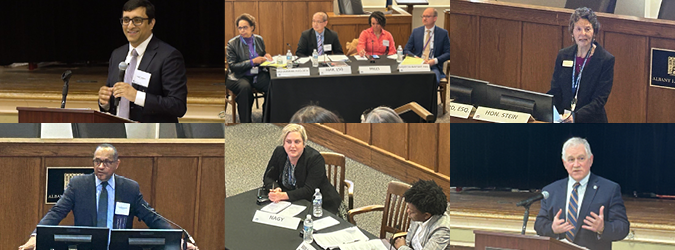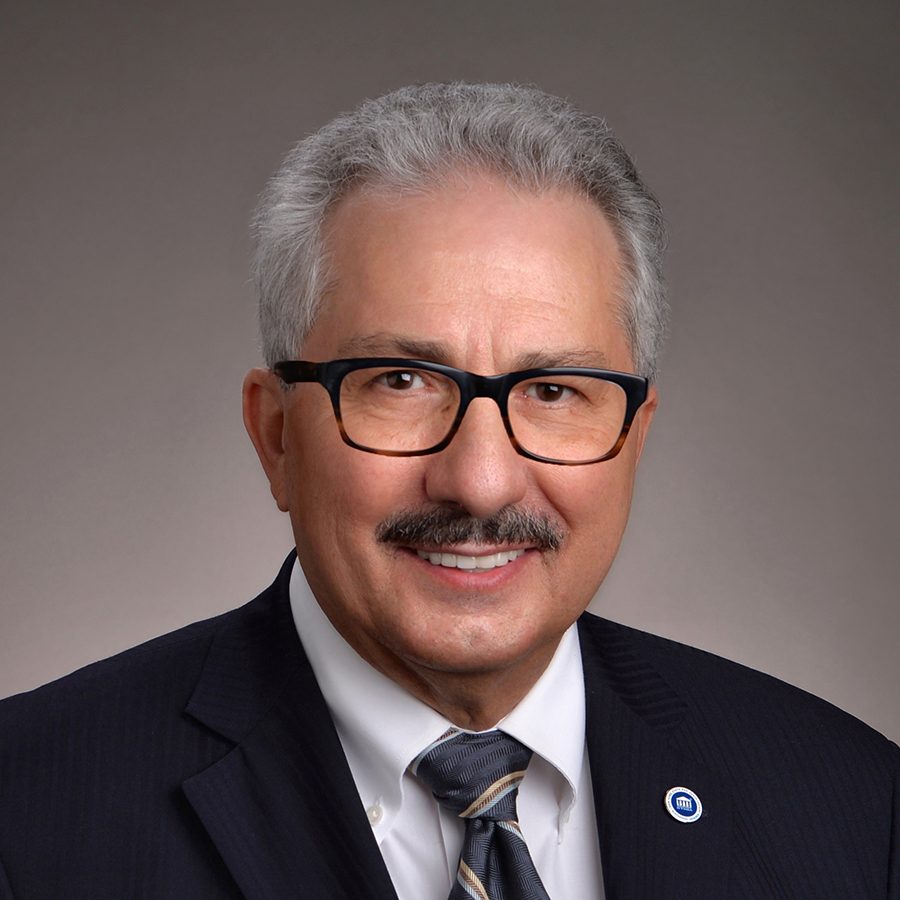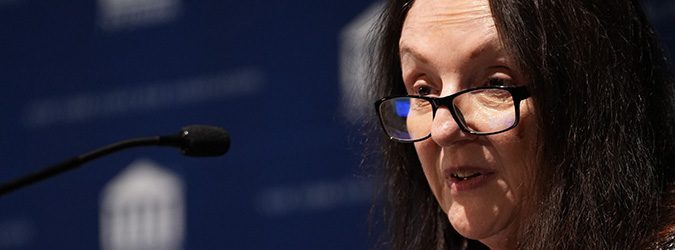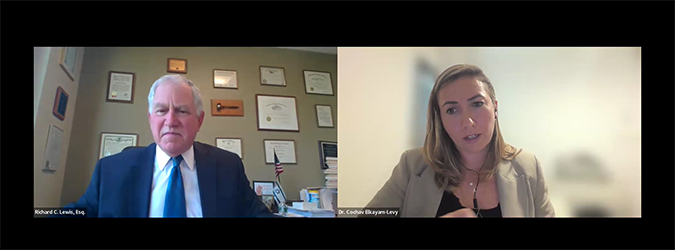Symposium Illuminates the Causes of Systemic Racism and Why Inequities Are Still Prevalent in Our Lives
3.22.2024
 The unequal outcomes of long-standing discriminatory laws and policies are still having an impact locally and nationally, speakers at a symposium presented by the New York State Bar Association and Albany Law School told participants.
The unequal outcomes of long-standing discriminatory laws and policies are still having an impact locally and nationally, speakers at a symposium presented by the New York State Bar Association and Albany Law School told participants.
The symposium examined how centuries-old approaches in housing, health and education have widened the wealth gap between various demographic groups. Nearly 20 experts spoke throughout the day-long event, which took place inside the Dean Alexander Moot Courtroom at the law school.
“Our conversation today matters and so we will not be silent — not today nor going forward — because our willingness to directly confront issues, especially those that permeate every facet of our lives, is the only way we can forge change. This symposium illustrates our efforts to tackle and rectify the deeply-embedded issue of systemic racism that has allowed unjust practices to prevail in our society to this day,” said New York State Bar Association President Richard Lewis in prepared remarks.
The January 2023 report of the association’s Task Force on Racism, Social Equity and the Law provided the basis for the day’s dialogue.
Even though it has been nearly 250 years since the Declaration of Independence was signed, more than 160 years after the Emancipation Proclamation was issued and 60 years after the Civil Rights Act was passed, the disparity that still exists illustrates racism’s deeply-rooted history.
“We’re all impacted by racism and the ills that flow from racism. Again, it’s our problem. An American story that’s baked into who we are. We have to all lay claim to it and own it together. We should all want a more just society, not only for ourselves, but our kids, future generations, people who aren’t born yet, it’s part of our obligation,” said T. Andrew Brown, a past president of the New York State Bar Association, in his closing remarks.
During his presidency, Brown launched the Task Force on Racism, Social Equity and the Law. Lillian Moy, former executive director of the Legal Aid Society of Northeastern New York and Taa Grays who is secretary of the bar association and vice president and associate general counsel of information governance for MetLife Legal Affairs, chaired it.
The inequities are evident through the criminalization of drug use in the health sector, a property tax funding model that drives more resources to affluent school districts and poor neighborhoods that lack amenities such as well-stocked grocery stores, speakers explained as more than 600 people listened in-person and virtually.
Ciji Dodds, associate professor of law and peace & conflict studies scholar at Albany Law School, noted during her morning keynote address that she wanted to present systemic racism in a manner that provided a unique perspective. She said the law offers an avenue for solutions to address disparities that have arisen through racism.
“It’s the nimbleness of the law that gives us all hope. It is the push and the pull of the law and the people who believe in the law as something that can be used for positive change. I think for most people here, at least because you’re here, you believe in the law. So, while we can recognize that there is inherent violence in our rule of law, we can all also recognize that we possess the power to choose how the law is interpreted and applied when it does not reach the standards that allow for equality and equity.”
Racism, Wealth Equity and Housing
Historic redlining has perpetuated socioeconomic and racial inequality across New York State, leading to segregated communities and disparate home ownership rates. The task force referenced a June 2021 Albany Times Union study that found that Black residents primarily lived in three downtown neighborhoods because of redlining that began nearly 100 years ago.
Samantha Darche, deputy superintendent for the Consumer Examinations Unit of the New York State Department of Finance, said her department regularly examines lenders to make sure they are meeting the needs of low- and moderate-income individuals in their neighborhoods, which is one of their legal obligations. Failing to meet that need will limit lenders’ ability to grow by, for instance, preventing them from acquiring another institution, she said.
Racism, Wealth Equity and Health
Such segregation is why community-based organizations are the lifeblood for addressing health and health care disparities that exist throughout the state according to Johanne E. Morne, executive deputy commissioner within the Office of Health Equity and Human Rights at the New York State Department of Health.
Greater attention and appreciation of an individual’s living conditions along with training for medical professionals regarding how implicit biases affect healthcare is among the recommendations in the task force report.
“We know that, based on the feedback from stakeholders, we cannot make determinations of need in the absence of people with lived experiences. People with lived experiences must be part of these discussions and that includes when we talk about prioritizing funding,” said Morne.
She also emphasized that it is critical that funding for health professional training include components that inspire change in a system that is overwhelmed by the outgrowth of COVID-19 pandemic issues and the nation’s burgeoning mental health crisis.
Racism, Wealth Equity and Education
Nelson Mar, senior staff attorney for Legal Services of New York City and a task force member, discussed the Dignity for All Students Act of 2010 that provides New York’s elementary and secondary school students with an environment that is free of discrimination and bullying. The law also mandates training for educators although he said it needs refinement, which is why the task force again recommended an implicit bias component within the training structure.
“The one area that is lacking is the issue of implicit bias and this is really important because going back to disproportionality, which is seen as one of the major reasons why we have disproportionality in suspension rates. Students who are Black will get longer suspensions and definitely will get suspended whereas students worldwide will either get a shorter suspension or not suspended at all.”
Jamaica Miles, co-founder and executive director of the All of Us Community Action Group, spoke on the impact school funding has had on her home school district of Schenectady where 44.7% of the population is non-white according to data provided in a 2023 Neilsberg Research report.
“Every year that Schenectady saw an increase in funding, we saw an increase in graduation rates. It makes a difference,” said Miles. “We live in the richest country in the world, in one of the richest states in the nation. It exists, but if we don’t do right by funding it then we intentionally are saying that we are OK with racist policies, practices and budgeting decisions that have happened since the beginning of this country.”
Brown closed out the symposium by calling upon members of the legal profession to continue their efforts toward eliminating such policies and practices.
“Many of us are lawyers, who better to advocate for change? Who is better? We speak as part of who we are, we write as part of who we are. That’s what we do. Our whole stock and trade is advocacy, whether we’re doing it right in front of people or writing it down, that’s who we are, that’s what we do. As a collective group, we are best equipped to address it.”






